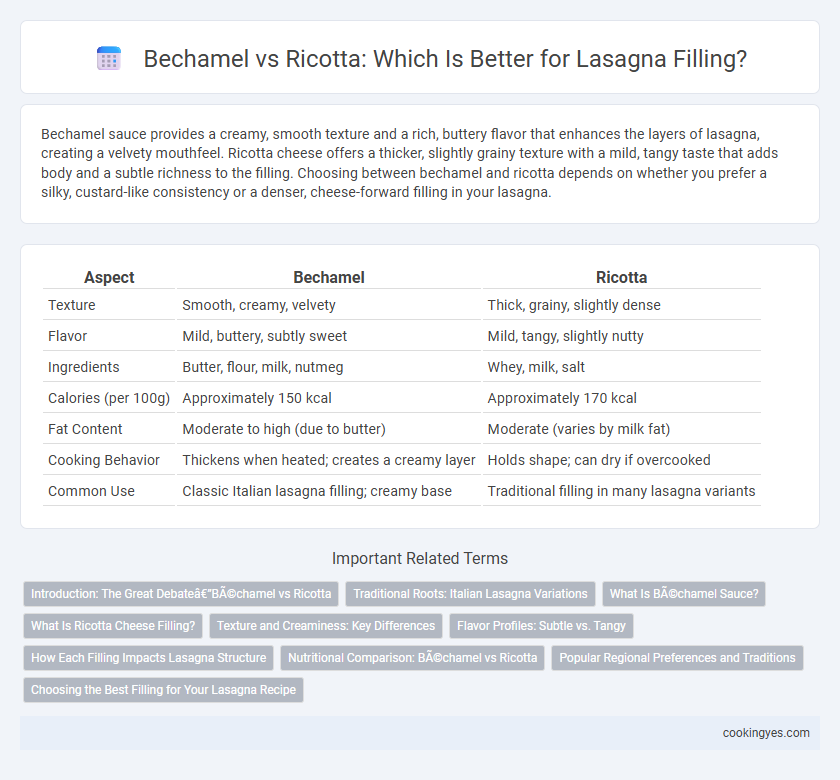Bechamel sauce provides a creamy, smooth texture and a rich, buttery flavor that enhances the layers of lasagna, creating a velvety mouthfeel. Ricotta cheese offers a thicker, slightly grainy texture with a mild, tangy taste that adds body and a subtle richness to the filling. Choosing between bechamel and ricotta depends on whether you prefer a silky, custard-like consistency or a denser, cheese-forward filling in your lasagna.
Table of Comparison
| Aspect | Bechamel | Ricotta |
|---|---|---|
| Texture | Smooth, creamy, velvety | Thick, grainy, slightly dense |
| Flavor | Mild, buttery, subtly sweet | Mild, tangy, slightly nutty |
| Ingredients | Butter, flour, milk, nutmeg | Whey, milk, salt |
| Calories (per 100g) | Approximately 150 kcal | Approximately 170 kcal |
| Fat Content | Moderate to high (due to butter) | Moderate (varies by milk fat) |
| Cooking Behavior | Thickens when heated; creates a creamy layer | Holds shape; can dry if overcooked |
| Common Use | Classic Italian lasagna filling; creamy base | Traditional filling in many lasagna variants |
Introduction: The Great Debate—Béchamel vs Ricotta
Bechamel sauce offers a creamy, velvety texture with a subtle buttery flavor that enhances traditional Italian lasagna, while ricotta provides a richer, denser filling with a slightly grainy consistency and tangy taste. The choice between bechamel and ricotta significantly influences the lasagna's moisture level, mouthfeel, and overall flavor profile. Understanding the distinct properties of each helps home cooks and chefs tailor the dish to their preferred texture and taste preferences.
Traditional Roots: Italian Lasagna Variations
Traditional Italian lasagna often features bechamel sauce as the creamy layer, especially in Northern Italy, where its smooth texture and subtle flavor balance the rich meat and tomato sauces. In contrast, ricotta cheese is more commonly used in Southern Italian lasagna variants, such as those from Naples, adding a denser, tangier filling that complements fresh herbs and mozzarella. Understanding these regional preferences highlights the authentic roots and distinct taste profiles that define Italian lasagna variations.
What Is Béchamel Sauce?
Bechamel sauce, also known as white sauce, is a classic French sauce made from butter, flour, and milk, creating a smooth and creamy base ideal for lasagna filling. It adds a rich, velvety texture and subtle flavor that complements the layers of pasta and meat or vegetables. Unlike ricotta, bechamel provides a more uniform consistency and moisture, enhancing the overall creaminess of traditional lasagna recipes.
What Is Ricotta Cheese Filling?
Ricotta cheese filling in lasagna is a creamy, slightly grainy mixture made from whey proteins, offering a mild and slightly sweet flavor that complements the dish's layers. Unlike bechamel, which is a white sauce made from butter, flour, and milk, ricotta adds a rich texture and protein content, making it a traditional choice in Italian lasagna recipes, especially in regions like Sicily and Campania. Ricotta blends well with herbs, eggs, and Parmesan, enhancing the overall taste and providing a distinct, moist filling that contrasts with the smooth, velvety consistency of bechamel.
Texture and Creaminess: Key Differences
Bechamel sauce provides a smooth, velvety texture with a rich creaminess that evenly coats lasagna layers, creating a cohesive mouthfeel. Ricotta offers a grainier, slightly dense texture with a mild, creamy flavor that adds body and a rustic quality to the filling. Choosing between bechamel and ricotta significantly impacts the lasagna's overall creaminess and mouth-coating experience.
Flavor Profiles: Subtle vs. Tangy
Bechamel sauce offers a rich, creamy texture with a subtle, buttery flavor that smooths the overall taste of lasagna, creating a delicate balance with tomato sauce and meat. Ricotta cheese provides a tangy, slightly sweet flavor that adds brightness and a more pronounced dairy note, enhancing the complexity of the filling. Choosing between bechamel and ricotta affects the lasagna's flavor profile, with bechamel delivering softness and warmth, while ricotta introduces a fresh, slightly acidic contrast.
How Each Filling Impacts Lasagna Structure
Bechamel sauce creates a smooth, creamy layer that enhances the lasagna's moisture retention and provides a silkier texture, allowing the pasta and cheese layers to meld seamlessly. Ricotta cheese contributes a denser, grainier structure that adds body and richness, offering a more substantial bite and distinct separation between layers. The choice between bechamel and ricotta fillings directly affects lasagna's overall firmness, mouthfeel, and the way the layers hold together during baking and serving.
Nutritional Comparison: Béchamel vs Ricotta
Bechamel sauce, primarily made from butter, flour, and milk, offers moderate calories with a rich source of calcium and some protein, while being relatively low in fat compared to ricotta. Ricotta cheese provides higher protein content and essential fats, along with significant amounts of calcium and phosphorus, contributing to muscle repair and bone health. Choosing between bechamel and ricotta in lasagna filling affects nutritional profiles, where bechamel is lower in protein but lighter in fat, and ricotta delivers more protein and healthy fats essential for a balanced diet.
Popular Regional Preferences and Traditions
In Northern Italy, bechamel sauce is the traditional choice for lasagna filling, especially in Emilia-Romagna where it adds a creamy, velvety texture complementing rich ragu. Southern regions, particularly Campania, favor ricotta cheese for its light, slightly tangy flavor that pairs well with tomato-based sauces and fresh herbs. This regional preference reflects cultural ingredients and culinary heritage, shaping the distinctive lasagna variations enjoyed across Italy.
Choosing the Best Filling for Your Lasagna Recipe
Bechamel sauce creates a creamy, smooth texture with a rich, buttery flavor that melts seamlessly into lasagna layers, offering a traditional Italian experience. Ricotta cheese provides a thicker, grainier consistency with a mild tanginess that adds heartiness and depth to the filling. Selecting between bechamel and ricotta depends on desired texture and taste, where bechamel suits silky comfort and ricotta enhances rustic, robust profiles.
Bechamel vs Ricotta for Lasagna Filling Infographic

 cookingyes.com
cookingyes.com